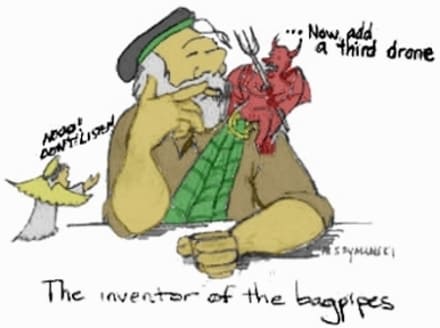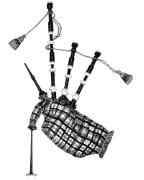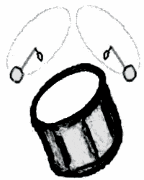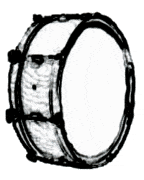INSTRUMENTS:
...what gear we play...
In the following, we'd like to introduce our instruments, their application and charakteristics. If you are interested in more details, just contact us. We always like to answer any question.

Great Highland Bagpipes
The scottish great highland bagpipes (short GHB) is one of the most famous kind of bagpipes.
Its origin is not in scotland - as often assumed - but rather somewhere in the orient. There were instruments found with an analogue structure (but mostly with windcaps instead of bags) dated about 2450 B.C. Presumably the roman empire invented the use of an leatherbag as air reservoire. After this, the instruments' journey along the whole mediterranean area until scotland began - therefore kinds of bagpipes exist in many countries along the mediterranean area.

In scottland the bagpipes were finally kind of "reinvented" to be a military instrument. After longtime use in wars, playing the bagpipes was - beside other celtic traditions - forbidden by the english men in 1745 A.C. Before the art of bagpiping was completely forgotten, it was allowed again and is nowadays very popular.
The GHB is not very adjustable in terms of volume. With different hard or soft reeds, otherwise identical instruments can be adjusted to a small degree. Just as the volume, the basic pitch of the instrument can also be adjusted only to a small degree.
Although the GHB has a quite restricted sound envelope, many tunes can be realized - but not all.
Drums (Sidedrum, Tenordrum, Bassdrum)
Characteristic for scottish bagpipe-music are the distinctive drums (besides the pipes themselfs). They subdivide into three kinds: sidedrum, tenordrum and bassdrum.

The scottish sidedrum is a kind of snaredrum and the tonal most distinctive one. The players build together with the so called "mid-section" (tenordrummers and bassdrummers) the "drumcorps". The scottish variant has also snares (like in normal snaredrums) below the vibrancy heads. Biggest difference is much higher tension of the heads. Therefore sidedrums are tonal much higher and "gaudy". The higher tension requires a more robust structure than snaredrums for drum kits. Also the drum sticks are more massive due to the higher rebound. Over the time own styles and techniques have developed.

The tenordrum is the tonal link between sidedrum and bassdrum. Tonal and rhythmical supplemental between side and bass the tenordrummers mainly attract attension due to the so called flourishing - the sticks are bound to the hands and are whirled dynamically through the air in different figures. Even for "normal" beats without flourishing, several beating-figures can be used (cross beats, ...). In traditional pipebands the tenordrummers build together with the bassdrummers the so called "mid-section". This term is derived from the typical circle-formation of the pipers and sidedrummers, with bass- and tenordrummers in the centre.

The bassdrum is the "heartbeat" of the drumcorps. It's the biggest and tonal most deep drum. The special design generates a very high acoustic pressure. Same as the other kinds of marching drums, it's worn directly on the body (in front of the breast). The primarily purpose of the bassdrum is to provide beat and tempo for the rest of the band, in our applications it's also often part of the rhythmical melody (like side and tenor). In some cases, bassdrummers use also flourishing (see tenordrum) but in a less distinct way due to the more unwieldy instrument.
Further instruments
As we always want to improve our music, we sometimes use further instruments. In this way we achieve a broader tonal spectrum and more musical variety. The "normal" pipeband instruments are also too loud for some occasions and/or locations.
Following further instruments are used if the occasion is right:
| Scottish smallpipes: | A smaller kind of bagpipes which was especially popular in the 18th and 19th century. They are compared to the GHB much quieter (low room volume) and have a deeper and softer sound with so called "romantic" intonation (higher notes are louder than lower notes - GHB intonation is vice versa). |
| Whistles / flutes: | Irish whistles as well as transverse flutes compliment with their brighter tone a perfect contrast to the deeper smallpipes and together a very lively tonal spectrum. |
| Bodhrán / Cajón: | The characteristic sound of the bodhrán is well known in irish folk music and compliments the sound of the smallpipes in a perfect way. The cajón is an instrument from peru, played with bold hands. We use it mainly as rhythmical background and support of the bodhrán. |


